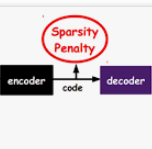This work presents an approach for image reconstruction in clinical low-dose tomography that combines principles from sparse signal processing with ideas from deep learning. First, we describe sparse signal representation in terms of dictionaries from a statistical perspective and interpret dictionary learning as a process of aligning distribution that arises from a generative model with empirical distribution of true signals. As a result we can see that sparse coding with learned dictionaries resembles a specific variational autoencoder, where the decoder is a linear function and the encoder is a sparse coding algorithm. Next, we show that dictionary learning can also benefit from computational advancements introduced in the context of deep learning, such as parallelism and as stochastic optimization. Finally, we show that regularization by dictionaries achieves competitive performance in computed tomography (CT) reconstruction comparing to state-of-the-art model based and data driven approaches.
翻译:这项工作提出了临床低剂量断层摄影图象重建的方法,这种方法将信号处理稀少的原则与深层学习的想法结合起来。 首先,我们从统计角度描述字典词典表达的信号稀少,并将字典学习解释为一种根据真实信号的实证分布的基因化模型所产生的分布协调过程。 因此,我们可以看到,与所学词典的稀疏编码类似于一种特定的变异自动编码器,其中解码器是一个线性功能,编码器是一种稀疏的编码算法。 其次,我们表明,字典学习也可以从深层学习背景下引入的计算进步中受益,例如平行主义和随机优化。 最后,我们表明,词典的正规化在计算图谱学(CT)重建与基于数据和数据驱动的状态模型方法相比取得了竞争性的绩效。
































